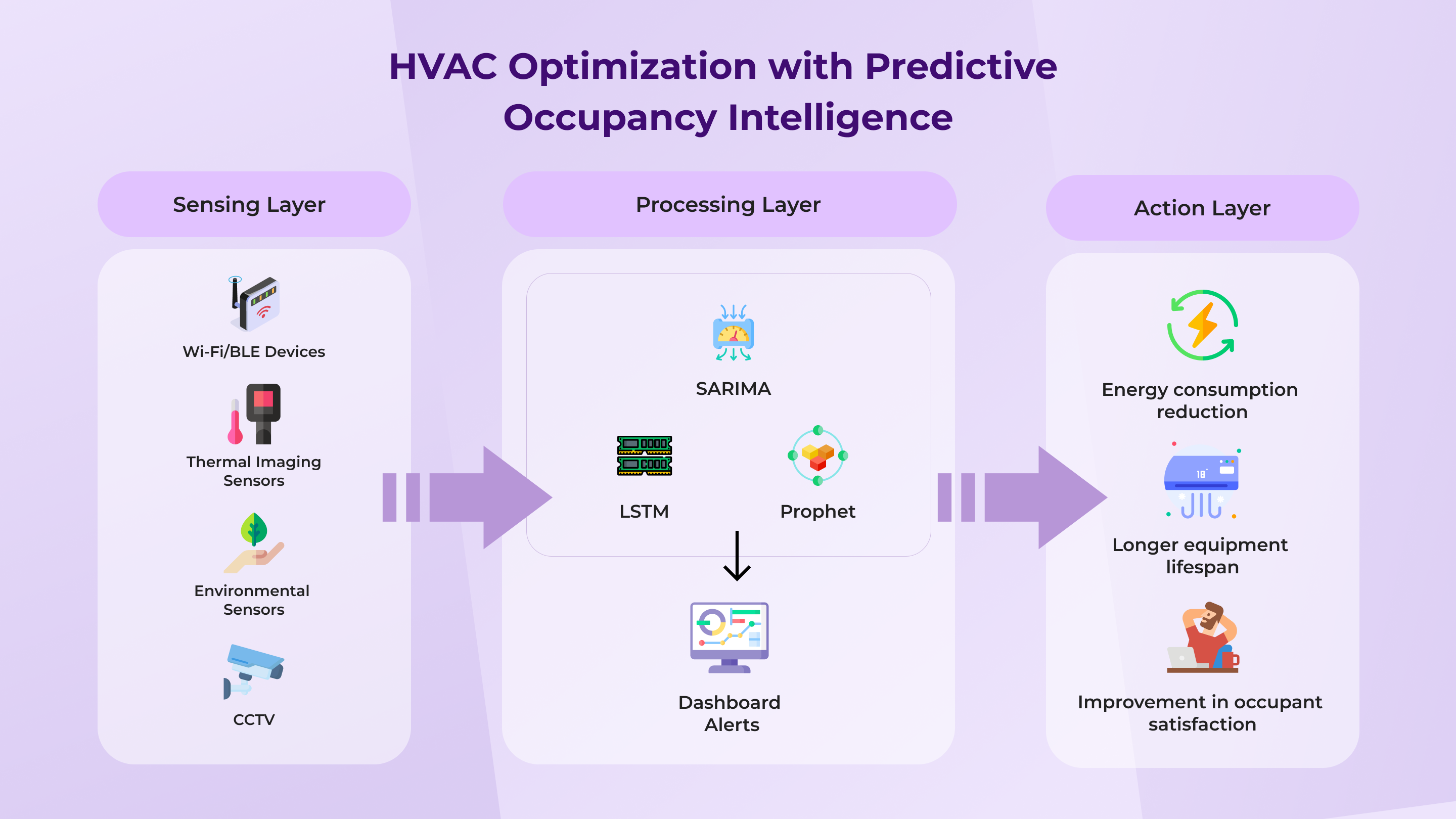Conventional HVAC systems, which often operate based on static schedules or basic motion sensors, are not well-equipped to handle the challenges of environments with variable, unpredictable occupancy patterns, such as university campuses, corporate buildings, or mixed-use spaces. While these methods automate some processes, they fall short in terms of accuracy and adaptability, resulting in energy waste, reduced equipment lifespan, and occupant discomfort.
The result is energy waste, reduced equipment lifespan, and occupant discomfort. Kloudspot’s solution, which addresses the challenge of conditioning spaces without knowing who’s present, offers significant benefits. By utilizing real-time occupancy intelligence, multimodal sensing, predictive analytics, and seamless integration with existing building systems, Kloudspot dynamically orchestrates HVAC operations, resulting in energy savings, extended equipment lifespan, and enhanced occupant comfort.

Real-Time Occupancy Estimation Using Multimodal Sensing
Kloudspot uses multiple sensor types to develop a live, zone-by-zone occupancy map that guides HVAC control:
BLE/Wi-Fi Device Presence
- Detects connected devices, including smartphones, laptops, and wearables.
- Helpful in estimating presence in shared or open areas.
- Privacy Considerations: Kloudspot applies anonymisation techniques and mitigates MAC randomisation to ensure compliance with privacy regulations, including the GDPR.
Thermal Imaging Sensors/CCTV
- Detect body heat for accurate, person-level counting.
- Effective in low-light or visually obstructed environments.
- Filters out false positives from inanimate motion (e.g., fans or shadows).
- Note: While thermal imaging is powerful, its deployment must consider installation complexity, costs, and potential privacy implications depending on local regulations.
Environmental Sensors
- Measure CO₂ levels, humidity, and temperature.
- High CO₂ levels often correlate with poor air exchange and occupancy.
- Adds context to presence data by indicating indoor air quality and comfort levels.
These diverse inputs are integrated in Kloudspot’s spatial intelligence engine, which generates dynamic occupancy maps that inform HVAC orchestration in real-time.
Predictive Occupancy Forecasting with SARIMA (and Alternatives)
What sets Kloudspot apart is not just real-time detection, but also the ability to anticipate occupancy before it occurs. This allows buildings to precondition spaces just in time, avoiding energy spikes while maintaining a comfortable environment.
Typically, Kloudspot uses SARIMA (Seasonal Autoregressive Integrated Moving Average) models to:
- Analyze historical room usage data
- Capture daily or weekly patterns
- Forecast occupancy in specific zones
- Schedule HVAC activation proactively
For instance, if a lecture hall is usually occupied at 9:00 AM on Mondays and Wednesdays, Kloudspot can initiate cooling at 8:45 AM, even when the space is unoccupied.
SARIMA assumes data linearity and stationarity, which may not hold in dynamic environments, such as campuses. For such cases, Kloudspot can deploy machine learning models like LSTM and Prophet that better capture nonlinear, nonstationary patterns in occupancy behavior, ensuring adaptability and effectiveness in any environment.
System Architecture: Built for Integration and Real-Time Response
Kloudspot does not replace existing infrastructure—it enhances it. The system integrates with major Building Management Systems (BMS), including Honeywell, Siemens, and Schneider Electric, through standard protocols:
- BACnet – For direct HVAC, lighting, and access control
- MQTT – For lightweight, efficient messaging in IoT environments
- REST APIs – For cloud-to-edge communication, analytics, and alerting
Where Processing Happens: Kloudspot’s platform supports edge processing for latency-sensitive functions such as real-time actuation, ensuring timely HVAC response even in bandwidth-constrained environments. Cloud processing is used for historical analytics and long-term modeling.
Outcomes: Energy Savings, Comfort, and Efficiency
Deployment of occupancy-aware HVAC orchestration has resulted in:
- 🔋 15–25% reduction in HVAC energy consumption
- 🛠️ 30% longer equipment lifespan due to reduced idle runtime
- 😊 Fewer comfort complaints from building occupants

Kloudspot’s occupancy-aware HVAC orchestration transforms traditional infrastructure into responsive, sustainable systems. By leveraging real-time sensing, predictive analytics, and open integration, buildings can now accurately determine when to heat or cool their spaces. While SARIMA models are effective in many structured environments, the platform’s flexibility to incorporate machine learning models ensures adaptability in dynamic, real-world conditions. Combined with edge processing and privacy-respecting data handling, Kloudspot provides a future-ready solution that strikes a balance between efficiency and user trust.